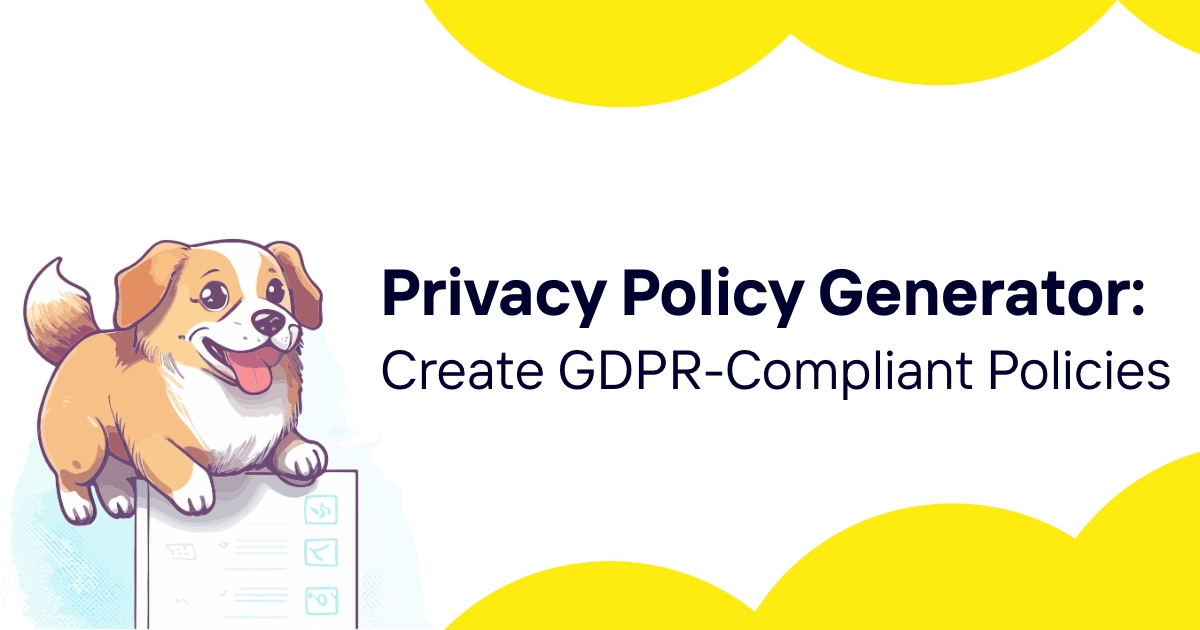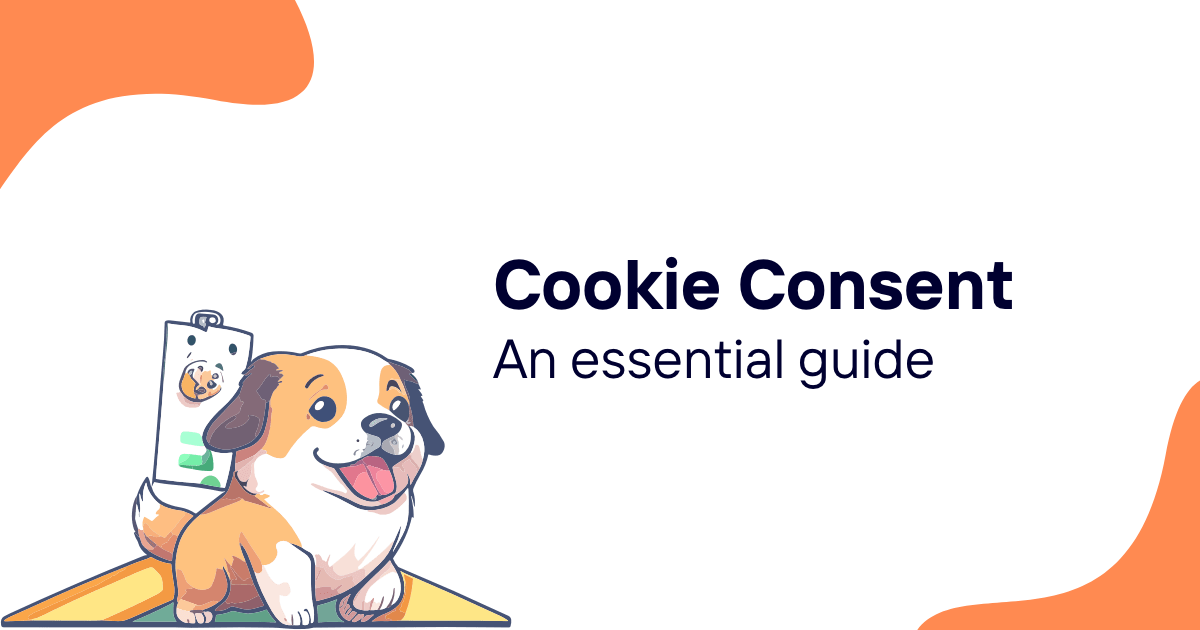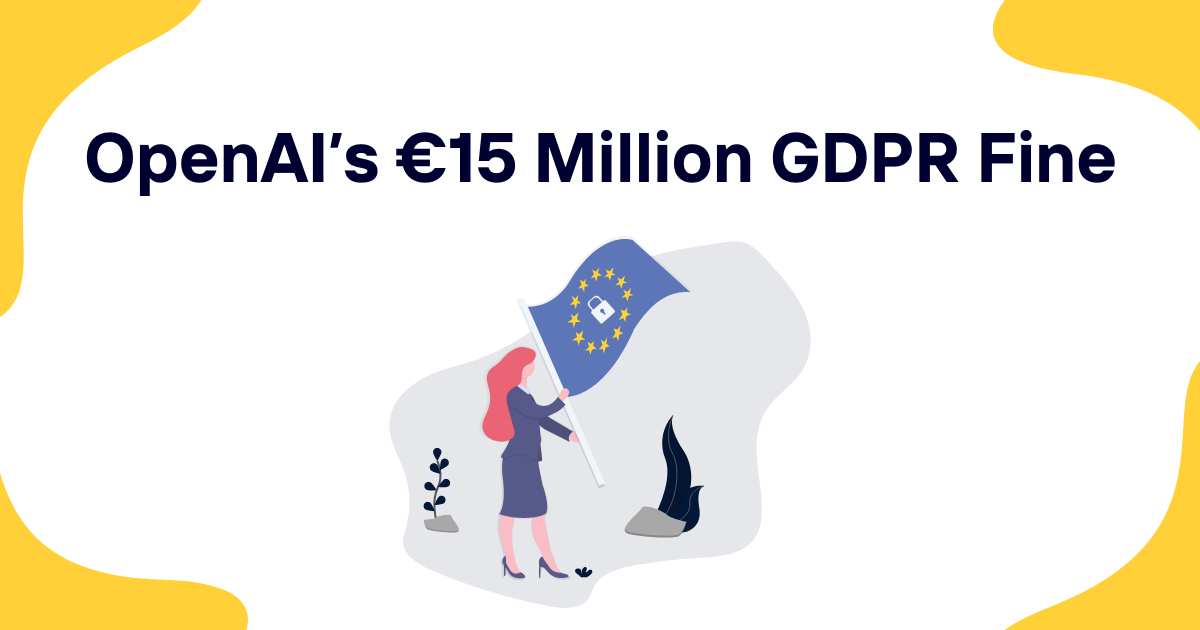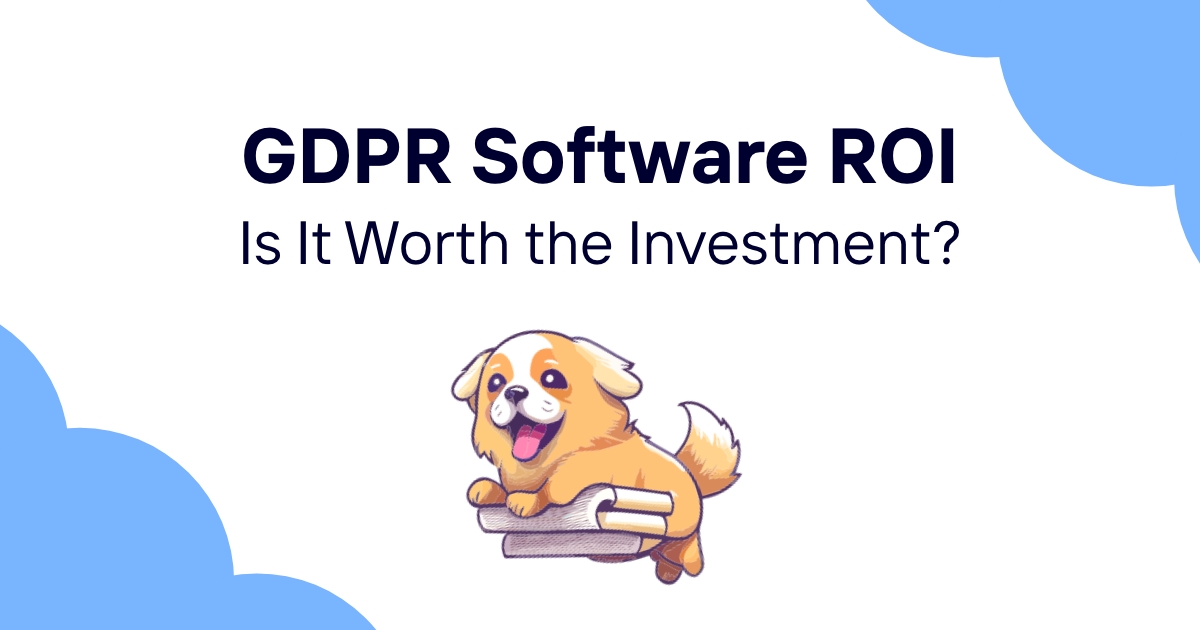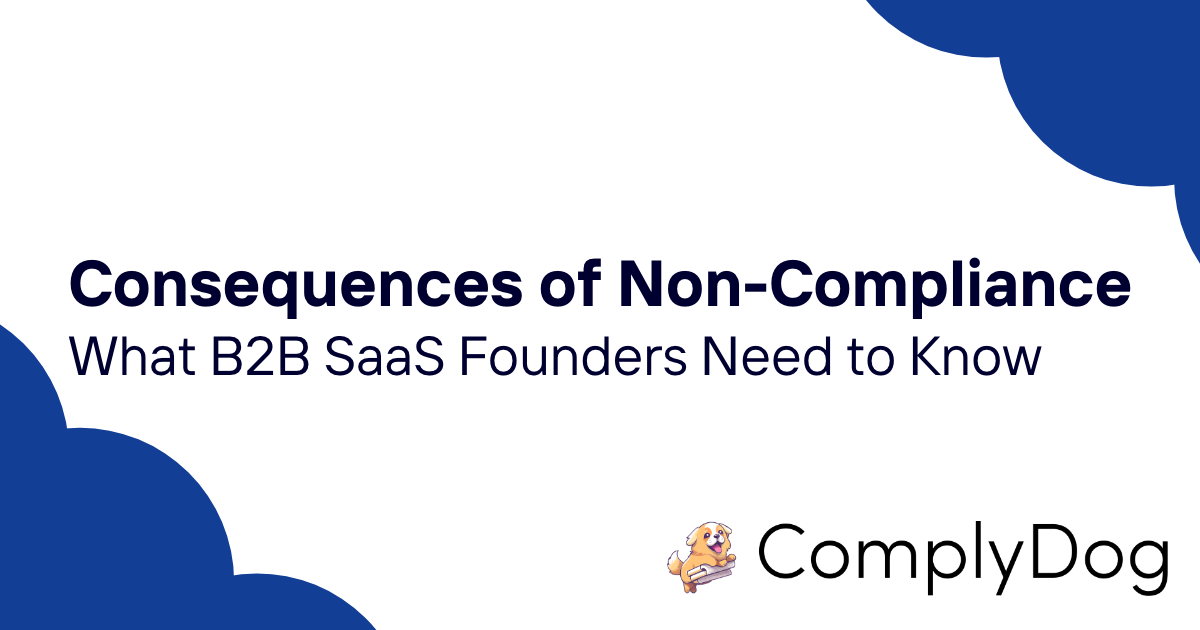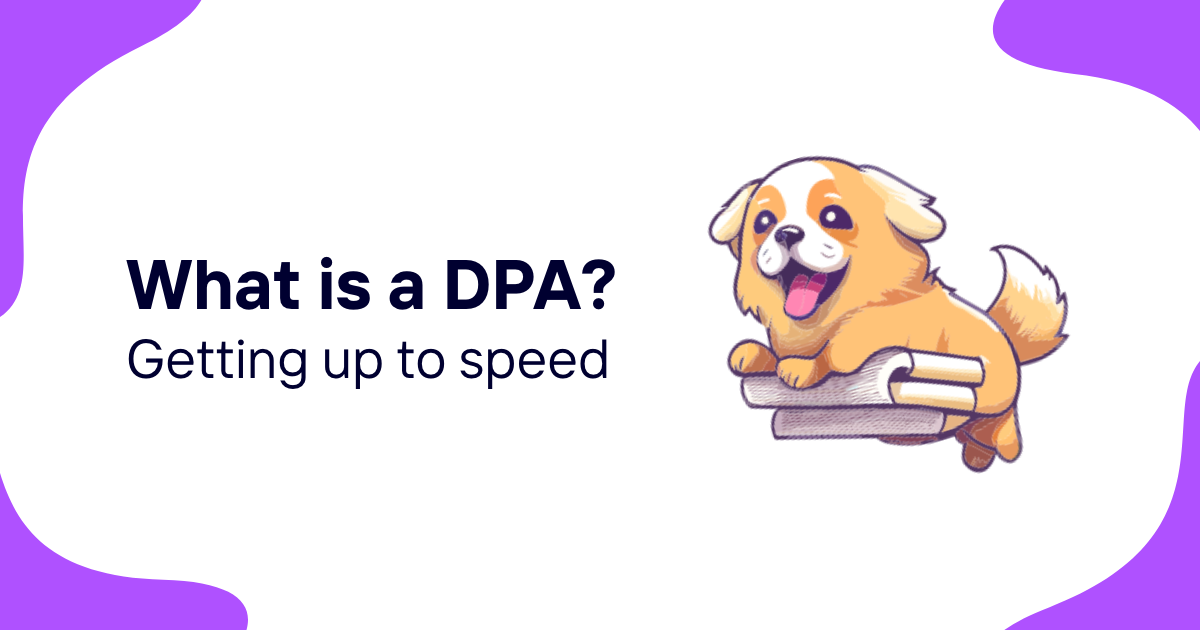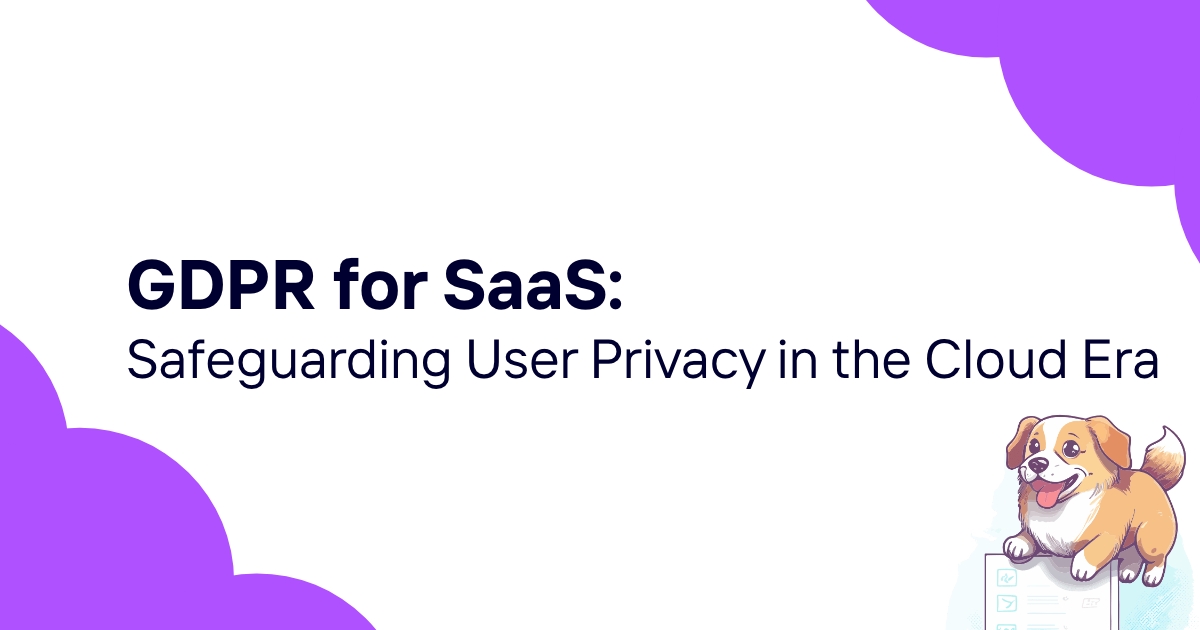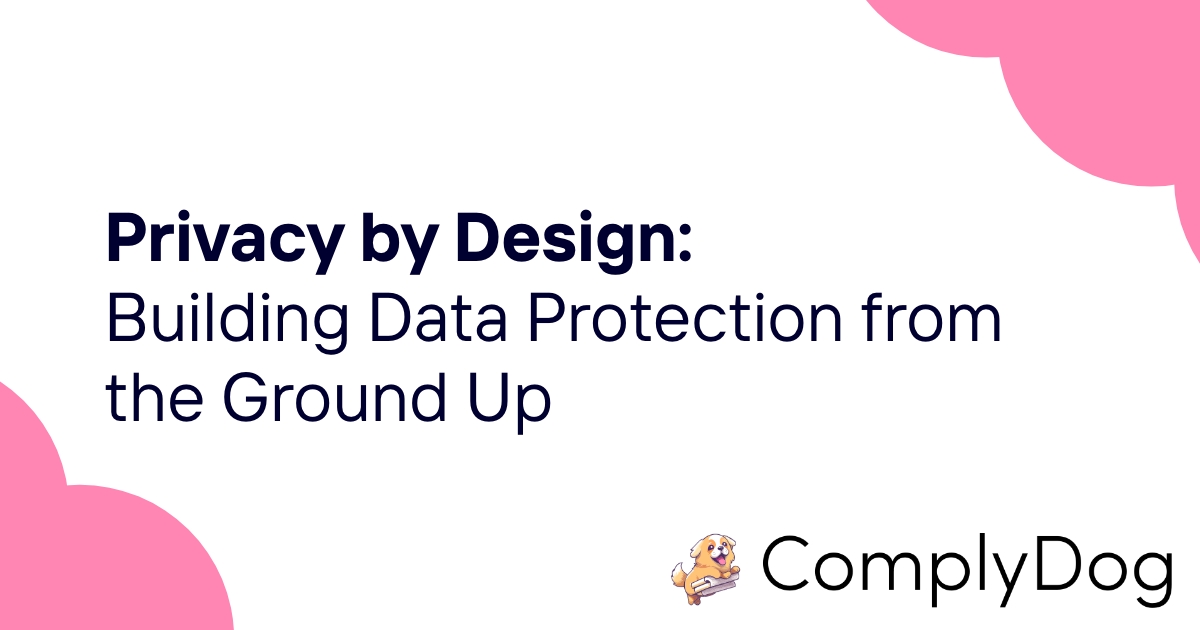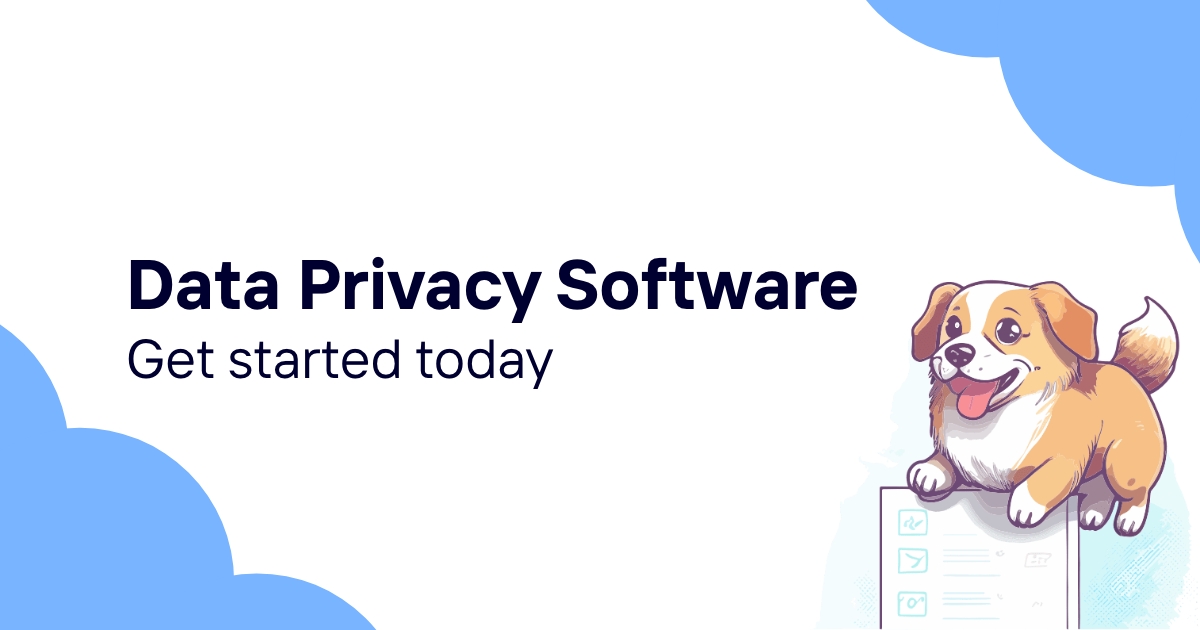Creating comprehensive privacy policies that comply with GDPR and other privacy regulations is essential for modern businesses, but writing them from scratch can be complex and time-consuming. Privacy policy generators provide efficient solutions for creating compliant policies while ensuring all required elements are included and properly structured.
This guide explains how privacy policy generators work, what makes policies GDPR-compliant, and how to choose and customize generated policies for your specific business needs. Understanding these tools helps organizations create effective privacy documentation without extensive legal expertise.
Why You Need a GDPR-Compliant Privacy Policy
GDPR-compliant privacy policies are not optional for businesses processing personal data of EU residents – they are legal requirements that form the foundation of transparent data processing and regulatory compliance.
Legal Compliance Requirements
Privacy policies serve as fundamental compliance documents under GDPR and other privacy regulations:
Documentation Gaps: GDPR Articles 13 and 14 require organizations to provide individuals with specific information about data processing activities through clear, accessible privacy notices.
Documentation Gaps: Data protection authorities actively enforce privacy policy requirements and impose significant penalties for non-compliance or inadequate disclosures.
Documentation Gaps: Privacy policies help organizations demonstrate compliance with GDPR's accountability principle by clearly documenting data processing practices and legal frameworks.
Documentation Gaps: Comprehensive privacy policies inform individuals about their rights and provide necessary information for exercising those rights effectively.
Documentation Gaps: Organizations operating internationally need privacy policies that address multiple regulatory frameworks while maintaining consistency and clarity.
Business Risk Mitigation
Well-crafted privacy policies protect organizations from various legal and business risks:
Documentation Gaps: Inadequate privacy policies can result in substantial GDPR fines reaching up to 4% of annual global revenue for serious violations.
Documentation Gaps: Clear privacy policies help establish reasonable expectations and limit liability for data processing activities within disclosed parameters.
Documentation Gaps: Transparent privacy practices enhance customer trust and protect organizational reputation in privacy-conscious markets.
Documentation Gaps: Strong privacy policies can differentiate organizations and attract customers who prioritize data protection and transparency.
Documentation Gaps: Privacy policies provide internal guidance for staff about appropriate data handling and help ensure consistent practices across the organization.
Customer Trust and Relationships
Privacy policies significantly impact customer relationships and business outcomes:
Documentation Gaps: Clear, honest privacy policies build customer confidence and demonstrate organizational commitment to data protection.
Documentation Gaps: Many customers consider privacy practices when making purchasing decisions, particularly for services involving sensitive personal data.
Documentation Gaps: Transparent privacy practices support long-term customer relationships by establishing clear expectations and demonstrating reliability.
Documentation Gaps: Excellent privacy policies can become competitive advantages that distinguish organizations in crowded markets.
Documentation Gaps: Well-designed privacy policies enhance overall user experience by providing necessary information without creating confusion or concern.
Stakeholder Communication
Privacy policies serve important communication functions for various stakeholder groups:
Documentation Gaps: Primary vehicle for explaining data practices to customers in accessible, understandable language.
Documentation Gaps: Privacy policies help business partners understand data handling practices and ensure compatibility with their own compliance requirements.
Documentation Gaps: Investors increasingly consider privacy practices when evaluating investment opportunities and business risks.
Documentation Gaps: Privacy policies provide regulators with detailed information about organizational data practices during examinations or investigations.
Documentation Gaps: Internal stakeholders use privacy policies to understand organizational commitments and ensure their activities align with disclosed practices.
Privacy Policy Legal Requirements
Comprehensive privacy policies must address specific legal requirements under GDPR and other privacy regulations while maintaining clarity and accessibility for ordinary users.
GDPR Information Requirements
GDPR Articles 13 and 14 specify mandatory information that privacy policies must include:
Documentation Gaps: Clear identification of the data controller including business name, address, and contact information for privacy inquiries.
Documentation Gaps: Contact information for the Data Protection Officer when organizations are required to appoint one.
Documentation Gaps: Specific purposes for data processing and the legal basis for each processing activity under GDPR Article 6.
Documentation Gaps: Description of categories of personal data processed, including any special category data requiring enhanced protection.
Documentation Gaps: Information about recipients of personal data including third-party processors, business partners, and international transfers.
Documentation Gaps: Specific retention periods for different types of personal data or criteria used to determine retention periods.
Documentation Gaps: Comprehensive explanation of individual rights under GDPR including access, rectification, erasure, restriction, portability, and objection rights.
International Transfer Disclosures
Organizations transferring personal data internationally must provide specific disclosures:
Documentation Gaps: Clear identification of all countries or international organizations that receive personal data.
Documentation Gaps: Information about European Commission adequacy decisions or lack thereof for destination countries.
Documentation Gaps: Detailed explanation of safeguards used to protect personal data during international transfers.
Documentation Gaps: Information about how individuals can obtain copies of relevant safeguards or where they are publicly available.
Documentation Gaps: Explanation of why international transfers are necessary for business operations or service delivery.
Automated Decision-Making Disclosures
When organizations use automated decision-making or profiling, additional disclosures are required:
Documentation Gaps: Clear statement about the existence of automated decision-making including profiling activities.
Documentation Gaps: Meaningful information about the logic involved in automated decision-making processes.
Documentation Gaps: Description of potential consequences of automated decision-making for individuals.
Documentation Gaps: Information about individuals' rights to obtain human intervention and contest automated decisions.
Documentation Gaps: Description of measures taken to ensure accuracy and prevent discrimination in automated systems.
Complaint and Contact Information
Privacy policies must provide clear information about individual recourse options:
Documentation Gaps: Multiple ways for individuals to contact the organization about privacy concerns including email, phone, and postal addresses.
Documentation Gaps: Information about typical response times for privacy inquiries and rights requests.
Documentation Gaps: Information about individuals' rights to lodge complaints with relevant data protection authorities.
Documentation Gaps: Contact details for relevant supervisory authorities or links to official authority websites.
Documentation Gaps: Clear procedures for escalating privacy concerns within the organization when initial responses are unsatisfactory.
As discussed in our DMCA compliance guide, digital platforms often need to address multiple legal frameworks including privacy and copyright requirements in their user-facing policies.
Key Components of Effective Privacy Policies
Effective privacy policies balance legal compliance with user comprehension through systematic organization and clear communication of complex information.
Information Collection and Usage
Clear explanation of data collection practices forms the foundation of effective privacy policies:
Documentation Gaps: Detailed description of how personal data is collected including direct provision, automatic collection, and third-party sources.
Documentation Gaps: Specific categories of personal data collected including contact information, usage data, technical information, and any special categories.
Documentation Gaps: Clear explanation of why different types of data are collected and how they support business operations and service delivery.
Documentation Gaps: Distinction between data that is required for service provision and optional data that enhances user experience.
Documentation Gaps: Information about when data is collected including registration, usage, and interaction-based collection.
Data Processing and Sharing
Comprehensive disclosure of data processing activities and sharing arrangements:
Documentation Gaps: Description of how personal data is used internally including analysis, customer service, and business operations.
Documentation Gaps: Information about automated processing including analytics, personalization, and decision-making systems.
Documentation Gaps: Detailed information about data sharing with service providers, business partners, and other third parties.
Documentation Gaps: Clear explanation of why data is shared and how sharing supports business operations and service delivery.
Documentation Gaps: Description of contractual and technical safeguards that protect personal data when shared with third parties.
User Rights and Controls
Clear explanation of individual rights and how to exercise them effectively:
Documentation Gaps: Detailed description of all applicable rights including access, correction, deletion, restriction, portability, and objection rights.
Documentation Gaps: Step-by-step instructions for exercising rights including required information and submission methods.
Documentation Gaps: Clear information about how quickly the organization responds to rights requests and any potential delays.
Documentation Gaps: Explanation of identity verification requirements that protect against fraudulent requests.
Documentation Gaps: Information about how individuals can appeal or escalate concerns about rights request responses.
Security and Protection Measures
Description of security measures demonstrates organizational commitment to data protection:
Documentation Gaps: Overview of technical security measures including encryption, access controls, and monitoring systems.
Documentation Gaps: Description of organizational security practices including staff training, access management, and security policies.
Documentation Gaps: Information about how the organization detects, responds to, and reports security incidents affecting personal data.
Documentation Gaps: Explanation of breach notification procedures and when individuals will be notified about security incidents.
Documentation Gaps: Description of ongoing efforts to maintain and improve security measures as technology and threats evolve.
Policy Updates and Communication
Clear procedures for policy maintenance and update communication:
Documentation Gaps: Explanation of how and when privacy policies are reviewed and updated.
Documentation Gaps: Information about how users will be notified of material changes to privacy practices.
Documentation Gaps: Clear indication of when policy changes take effect and any transition periods.
Documentation Gaps: Systems for tracking policy versions and enabling users to review previous versions when relevant.
Documentation Gaps: Commitment to ongoing communication about privacy practices and any significant changes.
Industry-Specific Privacy Policy Requirements
Different industries face unique privacy requirements that must be addressed in privacy policies alongside general GDPR compliance obligations.
Healthcare Industry Requirements
Healthcare organizations must address specific privacy requirements beyond general GDPR compliance:
Documentation Gaps: For organizations operating in the United States, privacy policies must address Health Insurance Portability and Accountability Act requirements for protected health information.
Documentation Gaps: Special handling requirements for health data including enhanced security measures and restricted sharing arrangements.
Documentation Gaps: Specific disclosures about health data use in research including de-identification procedures and consent requirements.
Documentation Gaps: Information about data sharing with healthcare providers, insurance companies, and other medical service providers.
Documentation Gaps: Specific rights under healthcare privacy laws that may differ from or supplement general privacy rights.
Financial Services Requirements
Financial institutions face specialized privacy requirements that affect policy content:
Documentation Gaps: Compliance with financial industry privacy laws including Gramm-Leach-Bliley Act and various banking regulations.
Documentation Gaps: Special handling requirements for credit information and financial transaction data.
Documentation Gaps: Information about data sharing with financial regulators and compliance with various reporting requirements.
Documentation Gaps: Disclosures about data processing for anti-money laundering and fraud prevention purposes.
Documentation Gaps: Special considerations for personal data used in providing financial advice and investment services.
Education Sector Requirements
Educational institutions must address unique privacy considerations for student and faculty data:
Documentation Gaps: Family Educational Rights and Privacy Act requirements for protecting student educational records.
Documentation Gaps: Enhanced protections for student personal data including restrictions on commercial use and data sharing.
Documentation Gaps: Specific rights for parents regarding their children's educational data and privacy preferences.
Documentation Gaps: Disclosures about educational data use in research and academic studies.
Documentation Gaps: Privacy considerations for educational technology platforms and online learning environments.
Technology and SaaS Requirements
Software companies face specific privacy policy requirements related to their business models:
Documentation Gaps: Policies addressing user content, intellectual property rights, and content moderation practices.
Documentation Gaps: Disclosures about data processing through application programming interfaces and third-party integrations.
Documentation Gaps: Detailed information about website analytics, user behavior tracking, and performance monitoring.
Documentation Gaps: Privacy implications of software updates, feature additions, and platform modifications.
Documentation Gaps: Data sharing with software developers, integration partners, and platform ecosystem participants.
As outlined in our TCF transparency framework guide, digital advertising and technology companies often need to address additional industry-specific transparency and consent requirements.
Privacy Policy Generator Features and Benefits
Modern privacy policy generators provide sophisticated tools that help organizations create comprehensive, compliant policies while saving time and ensuring consistency across different business contexts.
Automated Policy Generation
Advanced generators use intelligent systems to create customized policies based on business characteristics:
Documentation Gaps: Systematic questionnaires that gather business information and generate appropriate policy content based on responses.
Documentation Gaps: Pre-built templates designed for specific industries that address sector-specific requirements and common practices.
Documentation Gaps: Options to generate policies that comply with multiple regulatory frameworks including GDPR, CCPA, PIPEDA, and others.
Documentation Gaps: Generation logic that adapts policy content based on business models including SaaS, e-commerce, marketplace, and service platforms.
Documentation Gaps: Systems that automatically update generated policies when regulations change or business information is modified.
Customization and Flexibility
Effective generators provide extensive customization options while maintaining compliance integrity:
Documentation Gaps: Ability to modify generated content while maintaining legal compliance and required information elements.
Documentation Gaps: Options to integrate organizational branding, voice, and style while preserving legal accuracy.
Documentation Gaps: Multi-language generation capabilities that address international business requirements.
Documentation Gaps: Different output formats including web pages, downloadable documents, and mobile-optimized versions.
Documentation Gaps: Flexibility to add, remove, or modify policy sections based on specific business needs and requirements.
Compliance Verification
Quality generators include features that help ensure ongoing compliance:
Documentation Gaps: Built-in legal review processes that verify generated policies meet applicable regulatory requirements.
Documentation Gaps: Automated verification that policies include all required information elements for target regulations.
Documentation Gaps: Checks that ensure policy content is internally consistent and doesn't contain contradictory statements.
Documentation Gaps: Notification systems that alert users when regulatory changes might affect their generated policies.
Documentation Gaps: Assessment tools that rate policy compliance and identify potential improvement areas.
Integration and Management
Modern generators integrate with broader business systems and privacy management platforms:
Documentation Gaps: Tools for seamlessly integrating generated policies into websites and mobile applications.
Documentation Gaps: Systems for managing policy versions, updates, and historical records.
Documentation Gaps: Coordination with consent management platforms to ensure policy content aligns with consent collection practices.
Documentation Gaps: Integration with broader privacy management tools and compliance platforms.
Documentation Gaps: Tracking tools that monitor policy performance and user engagement.
Cost and Time Benefits
Privacy policy generators provide significant economic advantages over custom policy development:
Documentation Gaps: Substantial savings compared to hiring attorneys for custom policy development.
Documentation Gaps: Immediate policy generation compared to weeks or months required for custom development.
Documentation Gaps: Automated updates and maintenance that reduce ongoing legal and administrative costs.
Documentation Gaps: Ability to generate policies for multiple business units, websites, or services without proportional cost increases.
Documentation Gaps: Professional-quality policies that reduce compliance risks and potential regulatory penalties.
Customization Options and Templates
Effective privacy policy generation requires flexible customization options that address specific business needs while maintaining legal compliance and user accessibility.
Business Model Templates
Different business models require different privacy policy approaches and content emphasis:
Documentation Gaps: Policies designed for software-as-a-service companies addressing user accounts, data processing, API usage, and customer data handling.
Documentation Gaps: Policies tailored for online retail addressing customer information, payment processing, order fulfillment, and marketing communications.
Documentation Gaps: Policies for platforms hosting user-generated content addressing content rights, moderation practices, and community guidelines.
Documentation Gaps: Policies for multi-sided platforms addressing buyer and seller data, transaction processing, and third-party relationships.
Documentation Gaps: Policies for service providers addressing client relationships, project data, and professional obligations.
Industry-Specific Customizations
Industry-specific templates address unique regulatory requirements and business practices:
Documentation Gaps: HIPAA compliance features, health data protections, and medical privacy requirements.
Documentation Gaps: Banking privacy laws, financial data protections, and regulatory reporting requirements.
Documentation Gaps: FERPA compliance, student privacy protections, and educational data handling requirements.
Documentation Gaps: Entertainment software requirements, user content policies, and age-appropriate data handling.
Documentation Gaps: Advertising data requirements, tracking disclosures, and marketing automation privacy practices.
Geographic and Regulatory Customizations
Different jurisdictions require different privacy policy content and approaches:
Documentation Gaps: European data protection requirements including specific rights, legal bases, and international transfer disclosures.
Documentation Gaps: California privacy law requirements including consumer rights, opt-out procedures, and data sale disclosures.
Documentation Gaps: Canadian privacy law requirements including consent standards and complaint procedures.
Documentation Gaps: Policies that address multiple regulatory frameworks simultaneously while maintaining clarity and usability.
Documentation Gaps: Policy generation in appropriate languages for target markets and user bases.
Content and Style Customizations
Effective generators provide flexibility in content presentation and organizational voice:
Documentation Gaps: Options for formal legal language, conversational explanations, or mixed approaches based on audience preferences.
Documentation Gaps: Choices between comprehensive detailed policies and streamlined essential information presentations.
Documentation Gaps: Flexibility in organizing policy sections based on user priorities and information architecture preferences.
Documentation Gaps: Integration with website design elements including fonts, colors, and layout styles.
Documentation Gaps: Options for enhanced accessibility including screen reader compatibility and simple language alternatives.
Privacy Policy Maintenance and Updates
Effective privacy policies require ongoing maintenance and systematic updates to address changing business practices, regulatory requirements, and user needs.
Regular Review Schedules
Systematic review ensures policies remain current and accurate:
Documentation Gaps: Regular assessments of policy accuracy against current business practices and regulatory requirements.
Documentation Gaps: Detailed annual evaluations including legal review, compliance verification, and user feedback integration.
Documentation Gaps: Policy reviews triggered by significant business changes, new service launches, or regulatory developments.
Documentation Gaps: Regular review involving legal, privacy, business, and technical stakeholders to ensure comprehensive evaluation.
Documentation Gaps: Ongoing monitoring of policy effectiveness and user comprehension through analytics and feedback.
Change Management Procedures
Systematic change management ensures policy updates are handled appropriately:
Documentation Gaps: Evaluation of proposed changes for legal compliance, business impact, and user communication requirements.
Documentation Gaps: Clear approval workflows involving appropriate stakeholders including legal counsel and business leadership.
Documentation Gaps: Systematic version management that tracks policy changes and maintains historical records.
Documentation Gaps: Coordinated implementation across websites, applications, and other user touchpoints.
Documentation Gaps: Strategic communication about policy changes including timing, methods, and stakeholder targeting.
Regulatory Update Integration
Privacy policies must adapt to changing regulatory requirements and enforcement guidance:
Documentation Gaps: Systematic tracking of privacy law developments, enforcement actions, and regulatory guidance.
Documentation Gaps: Evaluation of how regulatory changes affect existing policies and business practices.
Documentation Gaps: Systematic implementation of policy changes required by new or modified regulations.
Documentation Gaps: Verification that updated policies maintain compliance with all applicable regulatory requirements.
Documentation Gaps: Comprehensive documentation of regulatory changes and policy adaptations for accountability purposes.
User Communication Strategies
Effective policy updates require clear communication with users about changes and implications:
Documentation Gaps: Clear notification about policy changes including effective dates and summary of modifications.
Documentation Gaps: Accessible explanations of why changes were made and how they affect users.
Documentation Gaps: Appropriate transition periods that give users time to review changes and adjust their preferences.
Documentation Gaps: Opportunities for users to update their privacy preferences in response to policy changes.
Documentation Gaps: Continued education about privacy practices and user rights following policy updates.
Common Privacy Policy Mistakes to Avoid
Understanding frequent privacy policy problems helps organizations create more effective policies while avoiding compliance issues and user confusion.
Content and Accuracy Issues
Many privacy policies suffer from fundamental content problems that undermine their effectiveness:
Documentation Gaps: Using template language that doesn't accurately reflect actual business practices or data handling procedures.
Documentation Gaps: Omitting required information elements or failing to address all data processing activities comprehensively.
Documentation Gaps: Internal contradictions between different policy sections or conflicts with other organizational policies and practices.
Documentation Gaps: Failing to update policies when business practices change or new services are launched.
Documentation Gaps: Using legal jargon that ordinary users cannot understand, reducing transparency effectiveness.
Legal Compliance Failures
Technical compliance failures can result in regulatory violations and legal exposure:
Documentation Gaps: Omitting mandatory information required by GDPR or other applicable privacy regulations.
Documentation Gaps: Misidentifying or misapplying legal bases for data processing activities.
Documentation Gaps: Failing to provide complete information about individual rights or clear exercise procedures.
Documentation Gaps: Inadequate disclosure of international data transfers and applicable safeguards.
Documentation Gaps: Providing incorrect or incomplete contact information for privacy inquiries and rights requests.
User Experience Problems
Poor user experience undermines policy effectiveness even when legal compliance is adequate:
Documentation Gaps: Policies that are difficult to find, read, or understand for users with different abilities and technical knowledge.
Documentation Gaps: Policies that don't work well on mobile devices or fail to provide appropriate mobile user experiences.
Documentation Gaps: Illogical information organization that makes it difficult for users to find relevant information quickly.
Documentation Gaps: Excessively long policies that discourage reading and comprehension.
Documentation Gaps: Failing to provide executive summaries or key points that help users understand essential information quickly.
Implementation and Maintenance Issues
Operational problems can undermine otherwise well-written policies:
Documentation Gaps: Policies that don't align with actual business practices or system implementations.
Documentation Gaps: Lacking systematic procedures for maintaining policy accuracy as business practices evolve.
Documentation Gaps: Failing to communicate policy changes effectively to users and stakeholders.
Documentation Gaps: Policies that aren't properly integrated with consent management, user interfaces, and other privacy controls.
Documentation Gaps: Insufficient documentation of policy development, review, and update processes for accountability purposes.
Building effective privacy policies requires balancing legal compliance with practical usability and clear communication. The most successful policies serve both compliance and business objectives while providing users with meaningful transparency and control.
For organizations seeking comprehensive privacy compliance that goes beyond policy generation to include systematic privacy management, integrated platforms often provide better results than standalone policy tools.
Ready to generate comprehensive privacy policies as part of broader privacy compliance management? Use ComplyDog and get integrated privacy policy generation combined with complete GDPR compliance management, consent tracking, and ongoing privacy program support that scales with your business needs.
